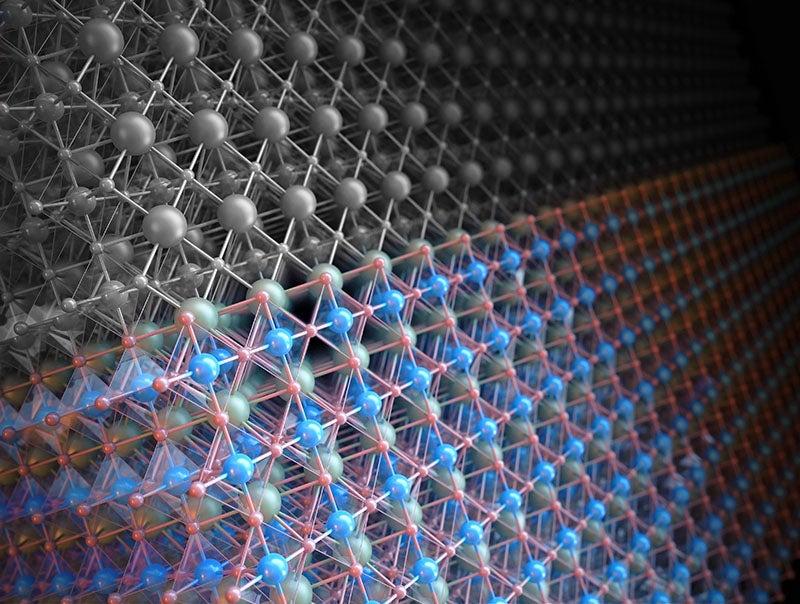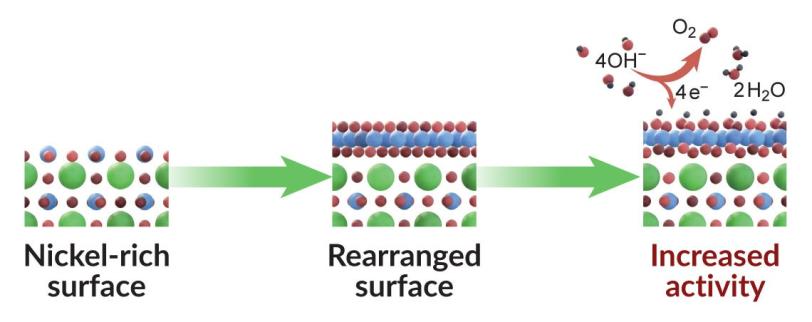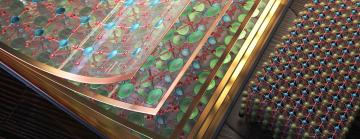Study shows tweaking one layer of atoms on a catalyst’s surface can make it work better
The surprising results offer a way to boost the activity and stability of catalysts for making hydrogen fuel from water.
By Glennda Chui
Scientists crafting a nickel-based catalyst used in making hydrogen fuel built it one atomic layer at a time to gain full control over its chemical properties. But the finished material didn’t behave as they expected: As one version of the catalyst went about its work, the top-most layer of atoms rearranged to form a new pattern, as if the square tiles that cover a floor had suddenly changed to hexagons.
But that’s ok, they reported today, because understanding and controlling this surprising transformation gives them a new way to turn catalytic activity on and off and make good catalysts even better.
The research team, led by scientists from Stanford University and the Department of Energy’s SLAC National Accelerator Laboratory, described their study in Nature Materials today.
“Catalysts can change very quickly during the course of a reaction, and understanding how they transform from an inactive phase to an active one is crucial to designing more efficient catalysts,” said Will Chueh, an investigator with the Stanford Institute for Materials and Energy Sciences (SIMES) at SLAC who led the study. “This transformation gives us the equivalent of a knob we can turn to fine-tune their behavior.”

Splitting water to make hydrogen fuel
Catalysts help molecules react without being consumed in the reaction, so they can be used over and over. They’re the backbone of many green-energy devices.
This particular catalyst, lanthanum nickel oxide or LNO, is used to split water into hydrogen and oxygen in a reaction powered by electricity. It’s the first step in generating hydrogen fuel, which has enormous potential for storing renewable energy from sunlight and other sources in a liquid form that’s energy-rich and easy to transport. In fact, several manufacturers have already produced electric cars powered by hydrogen fuel cells.
But this first step is also the most difficult one, said Michal Bajdich, a theorist at the SUNCAT Center for Interface Science and Catalysis at SLAC, and researchers have been searching for inexpensive materials that will carry it out more efficiently.
Since reactions take place on a catalyst’s surface, researchers have been trying to precisely engineer those surfaces so they promote only one specific chemical reaction with high efficiency.
Building materials one atomic layer at a time
The LNO investigated in this study belongs to a class of promising catalytic materials known as perovskites, named after a natural mineral with a similar atomic structure.
Christoph Baeumer, who came to SLAC as a Marie Curie Fellow from Aachen University in Germany to carry out the study, prepared LNO in what’s known as an epitaxial thin film – a film grown in atomically thin layers in a way that creates an extraordinarily precise arrangement of atoms.
Dividing his time between California and Germany, Baeumer made two versions of the film at different temperatures – one with a nickel-rich surface and another with a lanthanum-rich surface. Then the research team ran all the versions through the water-splitting reaction to compare how well they performed.
“We were surprised to discover that the films with nickel-rich surfaces carried out the reaction twice as fast,” Baeumer said.

Tuning a catalyst’s surface for better performance
To find out why, the team took the films to DOE’s Lawrence Berkeley National Laboratory, where a group led by Slavomír Nemšák looked at their atomic structure with X-rays at the Advanced Light Source.
“It was surprising that the difference between the ‘good’ and the ‘bad’ catalyst was only in the last atomic layer of the films,” Nemšák said. Those investigations also revealed that in films with nickel-rich surface layers that were prepared at cooler temperatures, the top layer of atoms transformed at some point during the water-splitting reaction, and this new arrangement boosted the catalytic activity.
Meanwhile, Jiang Li, a postdoctoral researcher and theorist at SUNCAT, performed computational studies of this very complex system using Berkeley Lab's National Energy Research Scientific Computing Center (NERSC). His conclusions agreed with the experimental results, predicting that the version of the catalyst with the transformed surface – from a cubic pattern to a hexagonal one – would be the most active and stable one.
Bajdich said, “Is the transformation of the nickel-rich surface driven by the way the catalyst is prepared, or by changes it undergoes while it carries out the water-splitting reaction? That’s very hard to answer. It looks like both have to occur.”
Although this particular catalyst is not the best in the world for splitting water into hydrogen and oxygen, he said, discovering how a surface transformation boosts its activity is important and could potentially apply to other materials too.
“If we can unlock the secrets of this transformation so we can accurately tune it,” he said, “then we can leverage this phenomenon to make much better catalysts in the future.”
The Advanced Light Source and the National Energy Research Scientific Computing Center are DOE Office of Science user facilities. Scientists from Forschungszentrum Juelich in Germany also contributed to this research. The project was funded by the DOE Office of Science, and Baeumer was also supported by the European Union’s Horizon 2020 research and innovation program through a Marie Sklodowska-Curie fellowship.
Citation: Christoph Baeumer et al., Nature Materials, 11 January 2020 (10.1038/s41563-020-00877-1)
For questions or comments, contact the SLAC Office of Communications at communications@slac.stanford.edu.
SLAC is a vibrant multiprogram laboratory that explores how the universe works at the biggest, smallest and fastest scales and invents powerful tools used by scientists around the globe. With research spanning particle physics, astrophysics and cosmology, materials, chemistry, bio- and energy sciences and scientific computing, we help solve real-world problems and advance the interests of the nation.
SLAC is operated by Stanford University for the U.S. Department of Energy’s Office of Science. The Office of Science is the single largest supporter of basic research in the physical sciences in the United States and is working to address some of the most pressing challenges of our time.






